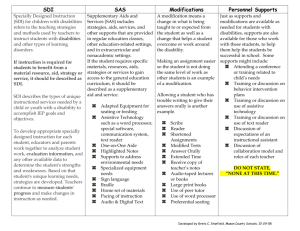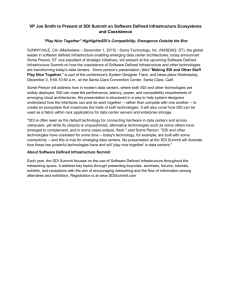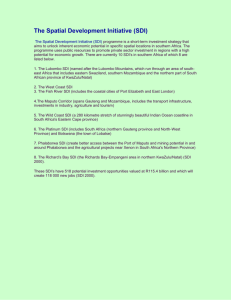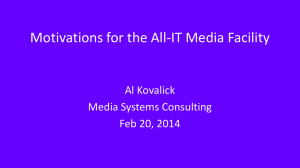Considerations for Subsurface Drip Irrigation Application in Humid and Sub-humid Areas
advertisement
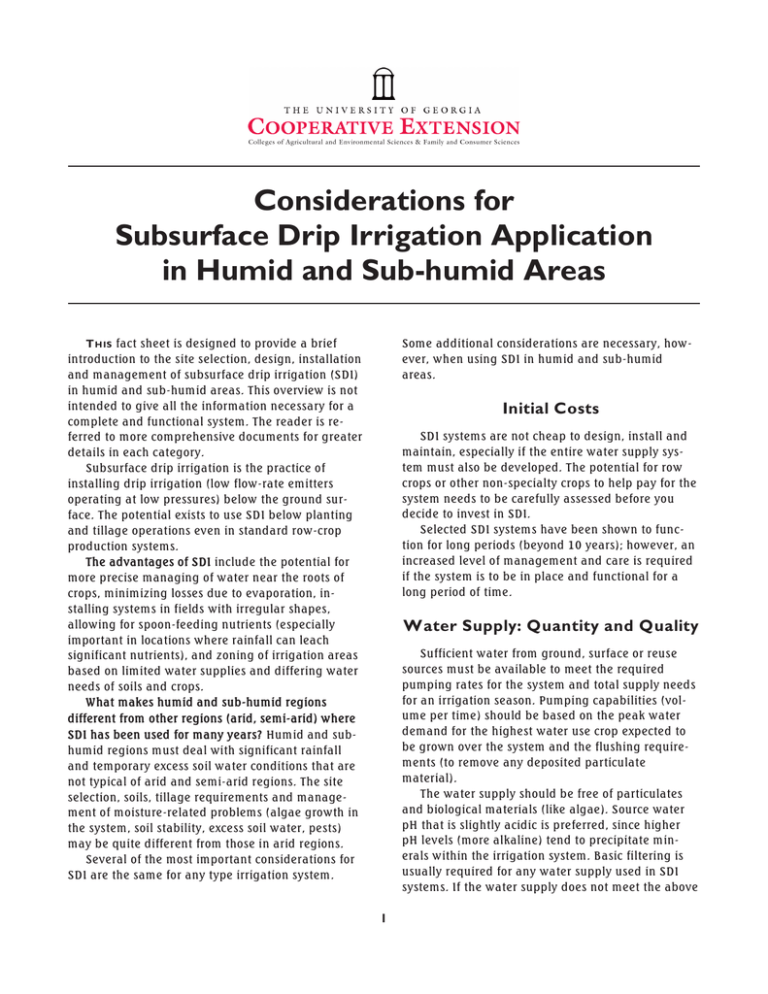
Considerations for Subsurface Drip Irrigation Application in Humid and Sub-humid Areas T H IS fact sheet is designed to provide a brief introduction to the site selection, design, installation and management of subsurface drip irrigation (SDI) in humid and sub-humid areas. This overview is not intended to give all the information necessary for a complete and functional system. The reader is referred to more comprehensive documents for greater details in each category. Subsurface drip irrigation is the practice of installing drip irrigation (low flow-rate emitters operating at low pressures) below the ground surface. The potential exists to use SDI below planting and tillage operations even in standard row-crop production systems. The advantages of SDI include the potential for more precise managing of water near the roots of crops, minimizing losses due to evaporation, installing system s in fields with irregular shapes, allowing for spoon-feeding nutrients (especially important in locations where rainfall can leach significant nutrients), and zoning of irrigation areas based on limited water supplies and differing water needs of soils and crops. What makes humid and sub-humid regions different from other regions (arid, semi-arid) where SDI has been used for many years? Hum id and subhumid regions must deal with significant rainfall and temporary excess soil water conditions that are not typical of arid and semi-arid regions. The site selection, soils, tillage requirements and management of moisture-related problems (algae growth in the system, soil stability, excess soil water, pests) may be quite different from those in arid regions. Several of the most important considerations for SDI are the same for any type irrigation system. Some additional considerations are necessary, however, when using SDI in humid and sub-humid areas. Initial Costs SDI systems are not cheap to design, install and maintain, especially if the entire water supply system must also be developed. The potential for row crops or other non-specialty crops to help pay for the system needs to be carefully assessed before you decide to invest in SDI. Selected SDI systems have been shown to function for long periods (beyond 10 years); however, an increased level of management and care is required if the system is to be in place and functional for a long period of time. Water Supply: Quantity and Quality Sufficient water from ground, surface or reuse sources must be available to meet the required pumping rates for the system and total supply needs for an irrigation season. Pumping capabilities (volume per time) should be based on the peak water demand for the highest water use crop expected to be grown over the system and the flushing requirements (to remove any deposited particulate material). The water supply should be free of particulates and biological materials (like algae). Source water pH that is slightly acidic is preferred, since higher pH levels (more alkaline) tend to precipitate minerals within the irrigation system. Basic filtering is usually required for any water supply used in SDI systems. If the water supply does not meet the above 1 SDI system that is too shallow. Soils that typically require deep sub-soiling are less amenable to subsurface drip irrigation. Under conditions where soils must be deep sub-soiled, the depth and location of the SDI laterals must be mapped extensively so the lateral lines are not damaged. Very sandy soils may have a limited capillary (upward) movement of water from the emitters that may cause difficulties in providing a sufficient amount of water during germination or plant establishment. A supplemental irrigation system may be necessary to assure plant establishment if rainfall is insufficient during the plant establishment period. Figure 1. Tyical components of a subsurface drip irrigation system. criteria, advanced filtering or even chemical treatment may be required due to the high potential for clogging of drip emitters. SDI systems can be designed for wastewater disposal and or treatment; however, proper care must be taken to include proper filtration and chemical injection treatment to prevent emitter plugging. Surface Slope Limitations If the topography is complicated, SDI systems are available with pressure-compensating emitters. These emitters are designed to discharge a similar flow rate as the elevation and slope changes. SDI systems, however, require a relatively low operating pressure typical for any drip system. Significant changes in slope can affect the available pressure to different parts of the field (high and low pressure). High pressures can cause drip lines to rupture, and low pressure can reduce the water output across a portion of the field. Energy Source Irrigation systems require an energy source to pump water and maintain the water pressure in an irrigation system. An electrical, diesel, natural gas or other energy source is selected based on availability, cost and accessibility. SDI systems do have operational controllers, however, that may be less desirable for use with a fossil fuel-based power system because the controllers may not be “on” all the time. Like other drip irrigation systems, SDI systems can be zoned to reduce the pumping rate, pump and power unit size, and energy requirements. As a result, the rate of energy use is lower. The time of operation will be extended, however, due to the low water application rates. Field Layout Limitations One advantage of SDI systems is that they can be more easily adapted to field sizes and shapes when compared to other types of irrigation systems. Field areas are not always circular (center pivot) or rectangular (large gun) area. The potential exists for an SDI system to irrigate only the best soils. Soil Limitations SDI systems do not have strict soil restrictions, except under the condition that a plow pan or other semi-impervious zone is located near the drip emitters. The desired distribution of water can be negatively affected by semi-impervious zones above or beside the emitters. There is some potential for benefit if the semi-impervious zone is below the emitters by reducing potential deep seepage and encouraging lateral movement of water. Soils prone to develop plow pans can use SDI and reduced (or no) tillage. Cropping operations that require periodic soil turning can quickly destroy an Figure 2. View of a drain plow used to install subsurface drip irrigation tubing. 2 • Is sub-soiling a part of the production system? • Are nutrient applications a critical part of your production system? Potential Disadvantages One disadvantage of SDI compared to other types of irrigation is that the infrastructure is permanent in the field. Because of this, SDI may not be economical to install on leased land. Costs for SDI can be high, especially if irrigation lines are placed below each row. Take care to maintain a consistent depth, spacing and location to reduce the potential for dam age from mechanical operations. The depth of tubing required for crops that have their fruit below the ground (such as peanut and sweet potato) may be too deep for effective early season irrigation. • Do you currently use an irrigation system that is not time intensive? Are you willing to spend more time on maintaining and operating an irrigation system like SDI? Is your available labor force willing and able to work with a new system that requires more care and effort? Each of the above questions generates a different set of design parameters from water supply to pumping requirements, location of components, depth of installation, spacing of drip laterals, automation requirements, etc. Soliciting input from trained personnel with SDI experience is a must if you anticipate using your system for 10 or more years. Installation of the designed system is critical to the performance expectations. How many times have “corners been cut” (less expensive materials, cheaper equipment, installation personnel who are not as experienced) in hopes of saving installation dollars? If the design does not take into account specific details of the field site, consult the designer about appropriate modifications. If connectors or other components are replaced due to availability issues, the system owner should have assurance of the life-span of these replacement components. Proper field layout prior to installation, proper equipment for installation to ensure depth precision, and permanent marking of buried lines after installation will all encourage a more efficient system. Timing of installation is one of the most critical factors in humid areas. Soil water characteristics (not too dry or too wet) during installation are critical. Installation of an SDI system is similar to a chiseling operation. If the soil water content is not acceptable for chiseling, it is likely not acceptable for drip installation. Fall is usually the best time for drip installation due to drier conditions (normally) and sufficient time for soil settling prior to planting. If you are planning to install your own SDI system, please take time to check other resource materials and visit with your local irrigation expert and others with SDI experience. Local Cooperative Extension representatives, NRCS personnel and irrigation dealers are good starting points for obtaining recommendations and information. What Will You Need for Your SDI System? Figure 1 shows the essential components of a well-designed SDI system. Care and m aintenance of all these components are essential for long-term and reliable operation. Other Design and Installation Considerations Locate operational system components in an easily accessible area for improved management. Any components that are to be located above ground should be strategically located away from potential traffic. All high points in the system should have air relief valves installed. Designs should include good flushing capabilities for laterals and mains. For SDI systems to function for a number of years, flushing capabilities are absolutely essential. You need to consider a number of critical design steps for creating an effective SDI system. A number of questions need to be answered before an adequate design can be completed: • Will the same crop be grown each year or will crops be rotated? • Do all crops to be grown have similar water use ch aracteristics? • Will the entire field be planted, or will the field be divided into smaller areas of different crops? • Does your field area grade from lighter soils (sands) to heavier soils (loams and clays)? • Will field crops (such as wheat, soybeans, rice) be grown in rotation to row crops? 3 Revi ewedOct ober2009

